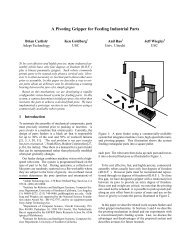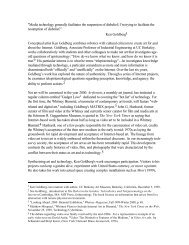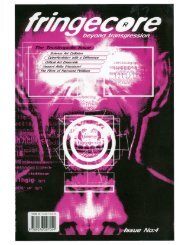“Are We There Yet?” Visual Tracking of Visitors ... - Ken Goldberg
“Are We There Yet?” Visual Tracking of Visitors ... - Ken Goldberg
“Are We There Yet?” Visual Tracking of Visitors ... - Ken Goldberg
You also want an ePaper? Increase the reach of your titles
YUMPU automatically turns print PDFs into web optimized ePapers that Google loves.
6 Are <strong>We</strong> <strong>There</strong> <strong>Yet</strong>?<br />
Quantize<br />
Gale-Shapley<br />
Bayesian<br />
Inference<br />
Morphological<br />
Filtering<br />
Connected<br />
Components<br />
Kalman Filter<br />
Bank<br />
Fig. 3. Algorithm Block Diagram. An image I(k) is quantized in color-space, and compared<br />
against the statistical background image model, ˆ H(k), to generate a posterior<br />
probability image. This image is filtered with morphological operations and then segmented<br />
into a set <strong>of</strong> bounding boxes, M(k), by the connected components algorithm.<br />
The Kalman filter bank maintains a set <strong>of</strong> tracked visitors ˆ Z(k), and has predicted<br />
bounding boxes for time k, ˘ Z(k). The Gale-Shapley matching algorithm pairs elements<br />
<strong>of</strong> M(k) with ˘ Z(k); these pairs are then used to update the Kalman Filter bank. The<br />
result is ˆ Z(k), the collection <strong>of</strong> pixels identified as foreground. This, along with image<br />
I(k), is used to update the background image model to ˆ H(k + 1). This step selectively<br />
updates only the pixels identified as background.<br />
1.4 Related Work<br />
The OpenCV computer vision library [6], [8], [17], [22] <strong>of</strong>fers a variety <strong>of</strong> probabilistic<br />
foreground detectors, including both parametric and nonparametric approaches,<br />
along with several multi-target tracking algorithms, utilizing, for example,<br />
the mean-shift algorithm [10] and particle filters [28]. Another approach<br />
applies the Kalman Filter on any detected connected component, and doesn’t<br />
attempt collision resolution. <strong>We</strong> evaluated these algorithms for possible use in<br />
the installation, although they exhibited low recall, i.e. visitors in the field <strong>of</strong><br />
view <strong>of</strong> the camera were too easily lost, even while moving. This problem arises<br />
from the method by which the background model is updated: every pixel <strong>of</strong><br />
every image is used to update the histogram, so pixels identified as foreground<br />
pixels are used to update the background model. The benefit is that a sudden<br />
change in the appearance <strong>of</strong> the background in a region is correctly identified<br />
as background; the cost is the frequent misidentification <strong>of</strong> pedestrians as background.<br />
To mitigate this problem, our approach uses dynamic information from<br />
the tracking subsystem to filter results <strong>of</strong> the segmentation algorithm, so only<br />
the probability distributions associated with background pixels are updated.<br />
The class <strong>of</strong> algorithm we employ is not the only class available for the<br />
problem <strong>of</strong> detecting and tracking pedestrians in video. A good overview <strong>of</strong> the<br />
various approaches is provided by Yilmaz et al. [40]. Our foreground segmentation<br />
algorithm is derived from a family <strong>of</strong> algorithms which model every pixel















